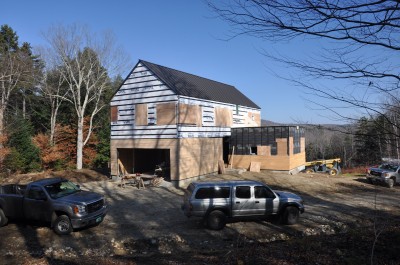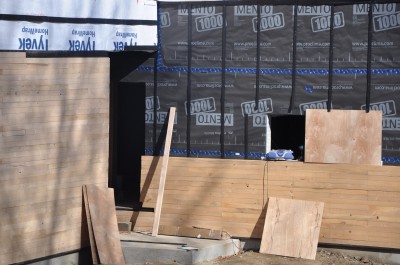Better Buildings conference 2019 - The path forward - file under musings
NESEA Pro tour - Hampshire College
Last month I toured the R.W. Kern center at Hampshire College with a bunch of Green building Geeks and fans as part of a NESEA pro tour. This building is being certified under the Living Building Challenge or LBC label. Pretty much the highest certification a building could achieve. Way beyond LEED. The architecture firm was Bruner Cott.
Side note: I met Simeon Bruner at Ashfield Stone without knowing who he was. (I don’t pay much attention to the goings on in my own industry) He told me his firm did Mass MOCA and I nearly fainted. Now Bruner/Cott is on my top list of firms that I follow and would like to work for. Except for the part where I rooted in Vermont and became a fuddy duddy.
The group also toured the Hitchcock Center architected by DesignLab architects and also built by Wright Builders. This building is also being built towards LBC certification. I can’t wait to see the finished product
NOVA NEXT ran an article about LBC and the Kern Center. The comments on the facebook are interesting and revealing. Education about green building is slower to trickle down than technology. We need gold standard buildings like this to learn from. Lessons learned go toward Hampshire college's goal of a net zero campus which then then are vetted and applied to the larger community. It also provides a learning tool for the current and next generation of thinkers who will apply those lessons elsewhere. Green building nowadays emphasizes durability and simplicity of systems in addition to energy use. This building will outlast most new buildings being constructed today and cost much less to own and operate. And attract the best and brightest students to the college. It's a win on so many fronts.
Here are a few photos I took during the tour plus a short video about the Hitchcock Environmental Center
Green Hemlock Siding on a Modernist house in Vermont
Construction is underway on this super insulated modern house in Vermont where we are trying out some very cool things.

Siding for instance. The lower siding is 1x3 green hemlock, unfinished from a local mill over insect screen over coravent strapping over Solitex mento 1000 building wrap from 475 supply over Vantem Sips..
The Solitex is a beautiful product, black and with UV protection which allows for an open gap siding treatment. I spec'd 1x3 local green hemlock because it is beautiful to work with when green, will shrink and gap in place as it dries and turn gray, The individual pieces are somewhat irregular so the overall effect is like a fabric. Very sexy and at a fraction of the cost of some other wood sidings. Hemlock is a very durable wood when left to weather. When I was a teenager working in a sawmill in Maine we cut a lot of hemlock to build a bridge over the crooked river. I also used it for much of the framing for my barn and I have many staging planks of hemlock. Because it is untreated all waste can be burned as kindling, or even tossed into the bushes to provide habitat for red backed salamanders. The photos show the window holes boarded up in preparation for the coming storm. I was there the day the glorious windows from Unilux were delivered. Next up: installing the windows - a very different affair than the standard American window with flanges.
Chris Corson, a builder in Maine working in the Passive House arena used raw pine in a similar fashion on this neat little project
the cost of power
Living in New England I do get tired of the rampant NIMBYism that goes on here. Wind power is a perfect example. We would rather get our power from coal and let other people deal with all the mining related issues which seem to me to be far more serious than the negative issues associated with wind. Most of those people who have to deal with the negative issues related to coal are poor and so they have much less political power than us middle class New Englanders. I suspect most of them would be happy to get their mountains back and put turbines on the ridges.

more on solar hot water - no boiler
An article by Alex Wilson of Environmental Building News in the local newspaper Brattleboro Reformer on solar water heating with some good local links. I have done a couple houses now with solar hot water backed up with a propane or electric heating element right on the storage tank to boost water temps when needed to serve as heat (radiant) and hot water. No boiler! Marathon Water Heaters are how you do it. see also passive house institute for more information trickling to this country from Europe about how to build carbon neutral-zero energy-heatyourhousewithacat homes
Also Coldham and Hartman architects have done something similar with a number of houses in the Northeast involving upgrading the shell of the house enough to be able to heat with a single space heater such as a through the wall gas space heater in the main living area.
My own house (900 square feet, 1970, poorly insulated cape) has a modern woodstove and electric radiant heat in the ceiling which we use primarily when we are away in the winter. We heat water with a plain old electric water heater. The presence of large sugar maple trees prevents us from utilizing the sun.
What clients come to me with
When I first meet with new or potential clients they usually have been working on their project for a year or more and have rudimentary plans sketched up as well as a laundry list of what they want. It is unusual for these two things agree with each other and I am in the position of delicately pointing this out. It reminds me of first year in architecture school when you work on a project day and night for a week and on presentation day someone on the jury picks up your model and says "this is crap" , hopefully followed by constructive critisism. At this point the project can go in at least two directions. The client can clam up and say " I know what I want and I just need it drafted up" or the client may realize that what they have come up with may be unneccesarily complicated and expensive as well as not really achieving all it could and welcome professional input. I don't discourage the drawings as they help me to see how people think and see. This helps me tailor what I do to maximize clear communication. Ideally, I can serve as their "jury" and coax/coach them into designing a scheme that meets all their stated (and implied) goals and perhaps even help them re-visit their stated goals to see if they are realistic. Before architecture school I spent a year in art school but dropped out beause of the lack of productive critisism of my work. If I put enough time into an assignment, I would get a high grade regardless of whether the project was actually good or not. When I got to architecture school, I welcomed the much higher level of artistic and intellectual rigor.
Put green building in a larger frame of reference, please
There is a lot of discussion lately about second homes and how can they be "green" given their very nature as inherently excessive. I thought I'd add some rambling and incoherent thoughts to the issue. I am often struck by the futility of the notion that we can actually do something significant to slow and reverse global climate change. I sometimes feel that perhaps my efforts should be much better spent in an area where I could make a larger difference that green building. I heard an interview (no reference or url here because I don't remember) with someone saying we should be putting our money and effort into dealing with climate change rather than combating it directly because we are way behind in a war that we cannot hope to win. Anything our government mandates or our people, specifically the American and Chinese people, would be willing to do or sacrifice is going to be way too little and way too late. We should be gearing up the ability of the world to quickly mobilize massive humanitarian efforts when large scale famine sets in - as would seem to be happening now. We should be looking at the ramifications of losing our oceans as a food source. What does it mean to return to a local economy - where would my underwear come from? Water allocation is a huge issue that will cost billions of people their lives not just their livelihoods in the coming decades. The spread of a disease that could wipe out half the world's population is a looming threat that scientists involved with such things refer to as a "when" not an "if". If you think the war in Iraq is costing a lot, just wait... We are soon going to be forced to make much larger changes than building green houses and getting rid of the SUV. So I look at the debate about second homes as being rather piddly and myopic. Phew, got that of my chest but now I don't feel better.
scary bad plastic
I'm sure everyone by now has heard assorted things about how bad for us (and not just the environment) plastic can be. Green Sage is an E-Zine that comes across my desk periodically and they have a concise article about the good and bad in regards to plastics.
Grandpa eloquence
Too good not to share: Bob, I wish I needed a house. You gave me lots of stuff on tree houses, though; and I read the books and think about tree houses the same way I think about Zeppelins and interurban trains and tiny Smart cars, all the great ideas I'd like to exploit. The house looks delightful. Some architct I read about today, a woman, said something like, architecture works when the occupant feel happy. Maybe thats Duh! but I have been in spaces that made me feel that the ceiling was going to come down and crush me, or the walls close in like that room in Poe's The Pit and the Pendulum. Large public spaces, like our Harris Theater in Millenium Center, give you a feeling of joyful anticipation when you walk in (holding, in my case, the convenient handrails).
My room here is so placed that I can see the moon over Rockefeller Center's tower as I lie in bed. That's a wonderful collaberation between architecture and astronomy.
Congratulations! Love,Allen
Composting Toilets in Vermont
With a title like this I'll probably get lots of google hits and lots of spam. An interesting note: We had intended to use composting toilets in the Perry Road Project but in Vermont this allows you to reduce the size of the leech field by only 25%. They also require you to have the septic folks take your compost away every year. Another factor in our decision not to use composting toilets is the cost. This is a very low budget house and composting toilets are pretty pricey. We will probably go with Toto low flow toilets. These have a very good reputation.
Complicated Budget Houses
I see many houses around here that would have benefited from some professional design help. It seems that people like to spend more money than they need to . These houses look complicated (if it looks complex then it is expensive) and yet they are obviously intended to be low cost housing. Not many people (or banks) "get" that spending money on an architect or designer up front can save them much more money in the months to follow during construction. Perhaps it is similar to solar hot water systems. Spend 5k to 7k up front and it takes 5 years or so before it is paid off in savings and then it starts saving money. It's like putting and extra $50 in the bank every month. That's an extra $6000 dollars over the next 10 years not counting for interest and certainly not counting for rising oil, gas or electricity costs. There was a picture in this month's "National Geographic" showing a Chinese subdivision from above. Many of the houses had solar hot water systems on the roof. They must be smarter than us.
FSC wood and blood on your hands
Uh oh, here I go getting political, in a semi-architectural way at least. I guess this is why I titled my blog "musings and mutterings" Don't buy non FSC certified hardwood such as mahogany. If you buy even one board, you have blood and exploitation on your hands. Yes, what you don't know may not hurt you but it may kill someone else. As Americans we are conditioned to turn a blind eye to issues of man's inhumanity to man in other areas of the world but please do what you can when you can and this is an easy one. Learn more: the Amazon Conservation Association and The Nature Conservancy
I also get much news and information from The Environmental News Network. Read this also for information on why you should avoid soy based foods and lots of information on cutting edge green building technologies. I also read Discover Magazine and National Geographic Magazine.
Passive Solar, Super-insulated...heat system?
Houses are getting too complicated. There are many people living in New England in houses that are warm and comfortable and only heat with wood and passive solar. My friend Steve is such a person. His house was built in the early eighties with large windows on the south and a descent amount of insulation by eighties standards. The temperature in his house is always 70 degrees in the winter even though he usually only fires up the wood stove a couple times per day. He uses no other heat source. When you build a new house at any budget level, it seems to be not a question that there is a significant heat system. As an architect, I periodically go to seminars on super-insulated passive solar houses where I hear that radiant heat is overkill and that you should consider a simple type of electric (future photovoltaics) backup heat near the plumbing (but you may never use it). No heat system, radiant or otherwise is a very hard sell as an architect. Maybe I should take people to Steve's house and let him be the salesman.






